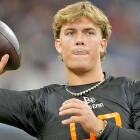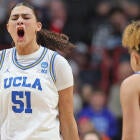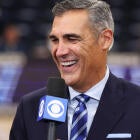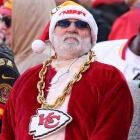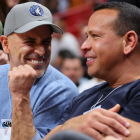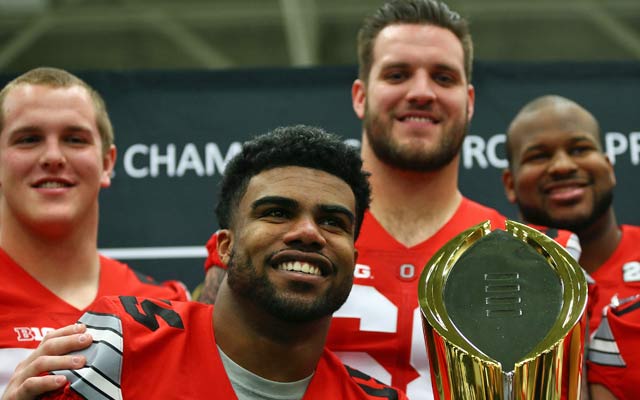
DALLAS -- The first College Football Playoff National Championship feels like a miniature Super Bowl.
There’s a $17 indoor football-themed fan festival with sponsorships -- nothing says college football like a free grooming lounge -- and a shop to purchase playoff-branded merchandise. There are concerts featuring Lenny Kravitz and Sting with face-value costs between $30 and $75. There's a $300 Taste of the Championship event with chefs modeled after the Taste of the NFL that precedes the Super Bowl.
Then, of course, there's Monday's Ohio State-Oregon game. Face-value tickets are $450 for a seat and $200 simply to stand. The average selling price on the secondary market has ranged from $700 to $1,300 -- and this will be one of college football's cheaper championship games in recent years. ESPN, which pays about $500 million a year for the rights to televise the playoff, surely will set another record for viewership of any cable program.
Ohio State offensive lineman Darryl Baldwin can't help but wonder where's some of that money for the players.
"Having this playoff is going to make a lot of money," Baldwin said while acknowledging the NCAA's new unlimited food plan has helped players. "To put it simply, us not getting any, I mean, it's nothing new, but it's unbelievable. You would think they would make a change about it, but they haven't."
Ohio State and Oregon players have received bowl gifts (the value can't exceed $550) and travel/meal stipends. Their parents now can receive up to $2,500 per family in reimbursement to attend the championship game, thanks to a last-minute interpretation by the NCAA. Still, the reality is that even when factoring in the cost of a scholarship and other benefits provided by schools, the amounts don't add up to the full value some players possess if they were allowed to capitalize off it.
The inaugural playoff provides the backdrop of an old issue that's evolving dramatically. Additional money for players will likely come in 2015-16 through cost-of-attendance stipends which will be passed next week at the NCAA convention. Debate will continue about how to pay athletes through the Ed O'Bannon ruling while complying with Title IX, whether players should make money off use of their own name, image and likeness, and what happens if the National Labor Relations Board sets a precedent by ruling Northwestern football players are employees who are free to unionize.
Over the past two weeks, CBSSports.com spoke with participants in the inaugural playoff about paying players. More than 30 players were first asked one simple question: "If you could change anything about the NCAA or college football, what would it be?" The overwhelming response: Let players get some money.
"We put a lot of time and effort into what we do and the football program brings in a lot of money to the school," Oregon defensive end DeForest Buckner said. "It's pretty much our job throughout college. We're up early, we go to bed late with meetings and practices. Coaches get a big bonus in their check. It would be cool to get a little piece of the earnings."
By reaching the CFP championship game, Ohio State coach Urban Meyer gets an additional $50,000 bonus and reached his on-field bonus maximum of $400,000 for the year. Ohio State's nine assistant coaches will accumulate almost $1.3 million for performance bonuses.
When asked whether it's time for players to be allowed to make money off their name, Meyer said he wants to think about that before answering. "Certainly, the player welfare is more important to me than handing them a check," Meyer said. "That includes the education, life after football, preparing them for life."
Oregon coach Mark Helfrich is up to $460,000 in on-field performance bonuses and can add $250,000 by winning the national title. Each Oregon assistant gets bonuses equal to four months' pay from their base salary because of the Ducks' semifinal victory. Helfrich envisions an ongoing battle involving other sports about whether players should be allowed to make money.
"I was joking with [Oregon safety] Reggie Daniels, [who also wears] No. 8 on our team [along with QB Marcus Mariota], and the propensity of the sales of Reggie Daniels jerseys right now is off the chart," Helfrich said, referring to the 25 different No. 8 jerseys Oregon has sold because it's the Heisman Trophy winner's number. "There's a lot of hurdles that have to be jumped. Absolutely, these guys deserve a chunk of that because they make it happen. If those guys aren't here, we don't have a job. If those guys aren't here, you [reporters] don't have a job."
Players want to make money off their name: The NCAA has long redefined the word "amateurism," as evidenced this week. The NCAA is now allowing the CFP to reimburse travel expenses for the families of Ohio State and Oregon to Texas, and the NCAA will do the same for players' families at the men's and women's basketball Final Fours.
The NCAA said it found a loophole in its bylaws that parents could receive money for travel if the payments came from the event organizer and not directly from the school. The common-sense decision, which happened after public pressure applied by Meyer, avoided the optics of parents facing financial strife to see their sons play because college football added one more game for two teams while pulling their kids out of classes. Players expressed gratitude that their families will better afford the trip, although the decision by the NCAA also could have Title IX implications if families of more female athletes are not reimbursed for trips.
The overwhelming opinion by CFP players interviewed for this article is they're not looking for salaries, they just want something more given the dollars being made around them.
"I totally agree that it shouldn't be an amount that you pay each player because how do you determine who gets paid more, who gets paid less?" Ohio State defensive tackle Adolphus Washington said. "But I feel like a player should be able to get paid off a signature or off their likeness because if they play good enough to where people want to give them money for a picture or give them money for a signature, I feel that's right because you've worked to get that notoriety."
Ohio State athletic director Gene Smith is the latest high-profile college administrator to say he could support group licensing for players to receive pooled money for use of their name, image and likeness. Notre Dame athletic director Jack Swarbrick came forward last month in support of the idea.
"I think it will work. You can manage it," Smith said. "I'm open to that if that's something we wanted to do. The challenge is, you were in college, you went to school, you know how mature or immature you were at 17, 18 years old. What we have to do is educate the student-athletes that first and foremost you’re here to get your education when you start going out there marketing yourself once your persona becomes valuable."
The next frontier for athletic departments may be providing financial training to college players and their parents. During the recruiting process, parents may want coaches and schools to explain how they're going to help their child manage extra licensing money coming their way.
"Keep in mind, when [players] come here, they have no value on that persona. We help develop that persona," Smith said. "So maybe Donatos Pizza wants to have an association with them so that may happen in your junior year. So how do we help them run that business so that they’re not skipping class to go run that business? So there's a way to do it, but you've got to keep all those things in mind. It's not as easy as people think."
It's highly debatable to say athletes have no value on their persona before arriving at a college, although universities certainly can significantly add to the value of a player. "The players are really what makes this thing go," Ohio State linebacker Joshua Perry said.
Smith acknowledged there's "no doubt" some players are worth more than their scholarship, "but out of 120 football players, how many actually have a market value? It depends on your local environment." Smith, who would receive more than $36,000 as a bonus if Ohio State wins the national title, said he is more interested in understanding players' needs and taking care of those -- for instance, child care for players -- than employee-employer deals.
Oregon athletic director Rob Mullens said he could "absolutely be at the table" when identifying direct revenue links to an athlete's name or likeness, such as jersey sales. "But on some of the other stuff, I think there's tremendous value in an education," said Mullen, whose original 2010 contract with Oregon included a $50,000 bonus when the Ducks reach a bowl game. "There's tremendous value in the experience offered to someone who's a student-athlete and sometimes I think that's overlooked."
If group licensing happens, the next great debate may be over how to divide a player's value based on his own individual worth compared the value added by the university. The fact that major athletic directors are now talking openly about the idea speaks to the NCAA losing the O'Bannon case (the NCAA is appealing) and the looming threat from the Jeffrey Kessler case of a free market for players to be paid.
"We finally got a crack in the hypocrisy line," O'Bannon attorney Michael Hausfeld said. "It’s because of the ruling and because of all the evidence upon which the ruling was based."
For years, a key question in the litigation has been what model NCAA members would be willing to live with to compensate players. Hausfeld said he hears of no behind-the-scenes discussion of reaching an agreement on a future model "other than maybe [new NCAA executive vice president] Oliver Luck, who appears to be the Jiminy Cricket for the NCAA. He has come out and said, 'Sure, the players deserve it.' "
'Best business scheme ever:' If ever there was a player made to capitalize off his name in college, it was Brian Bosworth. The Boz became his own personal marketing brand as a star linebacker at Oklahoma in the 1980s, often to the detriment of his team because of his outlandish actions and comments.
When the NCAA suspended Bosworth for the 1987 Orange Bowl because of a failed drug test, he wore a shirt on the sideline referring to the NCAA as "National Communists Against Athletes." After a long wait, Bosworth became an inductee this weekend into the College Football Hall of Fame. He insists he never wanted players to be paid and believes the only way it can work is if money gets shared among teammates.
"It was frustrating when I was playing that you couldn't go get a job in the offseason, and it takes money to live," Bosworth said. "You want to take a girl out, get pizza, go to a movie, get gas, just have a normal life. But how do you tell certain players that may have more notoriety go make money by signing your name on cards, but the guys that maybe don't have the same notoriety that are the workhorses that gave you the opportunity to get your name, they don't get that same recognition? Then you create dissension amongst the players and then the chemistry becomes in jeopardy."
Alabama offensive lineman Arie Kouandjo recently had to explain to his aunt how his scholarship stipend works because she thought players are paid a lot. By living off campus, Kouandjo said his stipend at Alabama is a little above $1,000 per month. That goes toward bills, food and gas, and he said money can be tight at the end of the month.
"I've run out of money for days," Kouandjo said. "We don't really have the time for jobs. Not everybody can go to their parents to ask for money. I probably would never do that if I could avoid it. Playing football, there's a lot of pressure that goes into it and time constraints. It's fun for us. It's not really a job, but it's something that makes money for somebody."
As Meyer put it, "College football is nothing more than a corporate America," drawing the parallel to corporations spending millions of dollars on leadership training just as Ohio State does for its players and coaches. The idea: Invest money to better educate players on life skills.
Buckeyes wide receiver Evan Spencer -- the player Meyer raves about as his team's MVP -- likes the training. He also notices the money increasing in college sports. Spencer reads reports that most states' highest-paid employees are college coaches while recognizing the contrast when witnessing some of his teammates send scholarship money home to care for their families.
Spencer doesn't pretend to have the answers -- "some bright minds need to come together to figure it out" -- but he believes a tipping point is coming.
"Some things are going to happen soon. They've got to," Spencer said. "I'm not saying it has to be in the form of a salary, but there should be more money given out. It's a perfect business model. You've got all these public officials, all these upper guys in the NCAA making millions upon millions, and their employees make nothing. Best business scheme ever."
>> Want more on CFP? Expert Picks
![[object Object] Logo](https://sportshub.cbsistatic.com/i/2020/04/22/e9ceb731-8b3f-4c60-98fe-090ab66a2997/screen-shot-2020-04-22-at-11-04-56-am.png)







